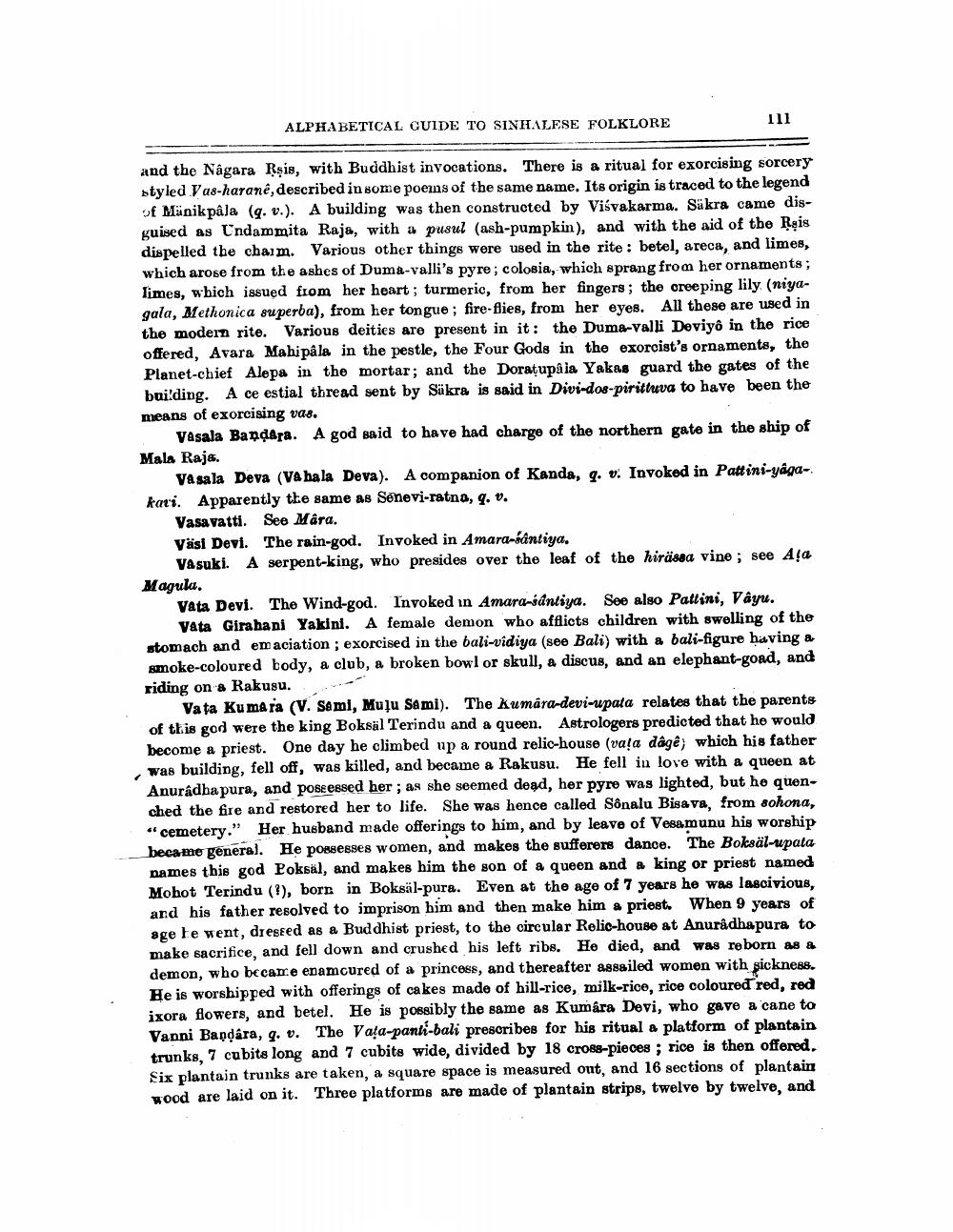________________
ALPHABETICAL GUIDE TO SINHALESE FOLKLORE
111
and the Nagara Rşis, with Buddhist invocations. There is a ritual for exorcising sorcery styled Vas-harané, described in some poems of the same name. Its origin is traced to the legend of Mänikpala (q. v.). A building was then constructed by Viśvakarma. Säkra came disguised as Undammita Raja, with a pusul (ash-pumpkin), and with the aid of the Rşis dispelled the chaim. Various other things were used in the rite: betel, areca, and limes, which arose from the ashes of Duma-valli's pyre; colosia, which sprang from her ornaments; limes, which issued from her heart; turmeric, from her fingers; the creeping lily (niyagala, Methonica superba), from her tongue; fire-flies, from her eyes. All these are used in the modern rite. Various deities are present in it: the Duma-valli Deviyô in the rice offered, Avara Mahi pâle in the pestle, the Four Gods in the exorcist's ornaments, the Planet-chief Alepa in the mortar; and the Doratupala Yakas guard the gates of the building. A ce estial thread sent by Säkra is said in Divi-dos-pirittuva to have been the means of exorcising vas.
Vasala Bandara. A god said to have had charge of the northern gate in the ship of Mala Raja.
Va sala Deva (Va hala Deva). A companion of Kanda, q. v. Invoked in Pattini-yaga-. kati. Apparently the same as Senevi-ratna, q. v.
Vasavatti. See Mara. Väsi Devi. The rain-god. Invoked in Amara-santiya.
Vasuki. A serpent-king, who presides over the leaf of the hirässa vine; see Aja Magula.
Vata Devi. The Wind-god. Invoked in Amara-santiya. See also Pattini, Vayu.
Vata Girabani Yakini. A female demon who afflicts children with swelling of the stomach and emaciation ; exorcised in the bali-vidiya (see Bali) with a bali-figure having a smoke-coloured body, a club, a broken bowl or skull, a discus, and an elephant-goad, and riding on a Rakusu.
Vata Kumara (V. Sami, Muļu Sami). The Kumara-devi-upata relates that the parents of this god were the king Boksal Terindu and a queen. Astrologers predicted that he would become a priest. One day he climbed up a round relic-house (vala dâge) which his father was building, fell off, was killed, and became a Rakusu. He fell in love with & queen at Anuradhapura, and possessed her; as she seemed dead, her pyre was lighted, but he quenched the fire and restored her to life. She was hence called Sônalu Bisava, from sohona, * cemetery." Her husband made offerings to him, and by leave of Vesamunu his worship became general. He possesses women, and makes the sufferers dance. The Boksäl-upata names this god Poksal, and makes him the son of a queen and a king or priest named Mohot Terindu (?), born in Boksal-pura. Even at the age of 7 years he was lascivious, and his father resolved to imprison him and then make him a priest. When 9 years of age te went, dressed as a Buddhist priest, to the circular Relic-house at Anuradhapura to make sacrifice, and fell down and crushed his left ribs. He died, and was reborn as & demon, who became enamcured of a princess, and thereafter assailed women with sickness. He is worshipped with offerings of cakes made of hill-rice, milk-rice, rice coloured red, red ixora flowers, and betel. He is possibly the same as Kumara Devi, who gave a cane to Vanni Bandara, 4. v. The Vala-pank-bali prescribes for his ritual a platform of plantain trunks. 7 cubits long and 7 cubits wide, divided by 18 cross-pieces ; rice is then offered. Six plantain trunks are taken, a square space is measured out, and 16 sections of plantain wood are laid on it. Threo platforms are made of plantain strips, twelve by twelve, and




